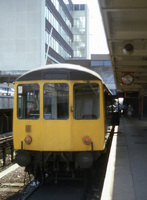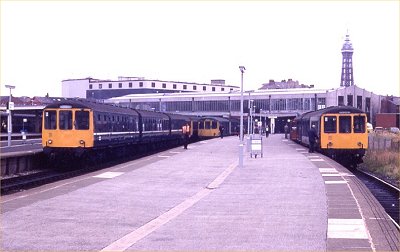Class 104 BRC&W 2, 3 & 4-car DMUs
Operations - Later Days
In service, the 104s worked over many routes on the BR network, covering most, if not all the DMU diagrams of their home depots. Throughout their lives being allocated to: Ayr, Bletchley, Buxton, Cambridge, Carlisle Kingmoor, Chester, Crewe North, Crewe South, Cricklewood, Darlington, Derby Etches Park, Eastfield, Hull Botanic Gardens, Hull Springfield, Leeds Neville Hill, Llandudno Junction, Longsight, Newton Heath, Norwich, Old Oak Common, Ryecroft, South Gosforth, Stoke, Stratford, Toton, Tyseley, York and Walsall Monument Lane. Of the routes worked by the class, the one they became synonymous with is the Buxton to Manchester Piccadilly 'Spa Line'.
At the end of 1965 the ten LMR power-trailer sets were re-allocated to Longsight depot, nine (with DMBSs 50532-40) coming from Newton Heath, the other (with DMBS 50541) moving from Cockshute. They would remain at Longsight until the early 1980s, and along with Class 108s that arrived from Chester they would take over the duties of the Yellow Diamond sets (allowing them to be withdrawn) on services such as to Hayfield.
In April 1966 Cockshute depot lost its DMU allocation. It had thirty three-car BRC&W sets, the twelve lowest numbered (with DMBSs 50439/40/2-51) went to Monument Lane, the eighteen higher numbered (with DMBSs 50452-69) sets moved to Longsight. Their stay at Longsight was less that a year, in January 1967 they moved on to Newton Heath. These changes were likely to be in connection with the electricfication of Macclesfield, Stoke and Stafford services in December 1966.

On September 28 1967 a three-car set (freshly painted in blue, full yellow end, white roof dome) was used on 1T61, a Hope Valley timing run. This was to see if a timing of less than an hour could be achieved with a non-stop service between Manchester Piccadilly and Sheffield Midland, the special scheduled for 59 minutes.[1]
The first image shows BRC&W sets at Buxton in August 1971. Set BN451 is on the left, in the centre road with a red buffer beams is power-twin BN460 (BN signified a Buxton set). Behind is a three-car set. Mel Smith.
Blackpool was a frequent haunt for the class, as shown in the first image, with the class working Manchester Victoria to Blackpool North services for many years. There was a dedicated fleet for the diagrams, which had bogie modifications for an improved ride and identified by the 'white stripe' on the sides. Taken on August 3rd 1979, the vehicles are 50524 + 59183 + 50475, 50504 + 59160 + 50452, 50477 + 59185 + 50529 and 50517 + 59173 + 50465. Robert Frise.
They were also known to work to Skegness, on summer Saturday services from Manchester Piccadilly, as well as the occasional excursion.
In October 1981 sets made redundant in the Manchester area moved south and replaced the 105s on the Bedford and St Albans branches.
At the start of 1984 ten vehickes were sent to Cricklewood, mainly from Newton Heath (53477 + 53529, 53453 + 53520, 53488 + 53436, 53501 + 53455, and 53492 + 53437), to replace the last four Class 127 hydraulic sets on the Barking - Gospel Oak services. In July one of those, 53480, was withdrawn with collision damage and 53522 was sent from Buxton as a replacement.

In the image the 10:33 Barking - Gospel Oak awaits time at Barking on Saturday 23rd August 1986, 53479 closest. Colin Brooks.
In 1984 Class 108s cascaded from Chester and Allerton to Longsight and Buxton allowed Class 104s in the Manchester area to be withdrawn (or sent to AY and CW). Surplus 120s, not suitable for the Buxton line due to their lower power / weight ratio, were transferred to Newton Heath releasing three-car Class 108s for Buxton. By late August Buxton had twelve 104 triples and five 108 triples.

Another Cricklewood collision victim was DMBS 53453, seen after 31 281 got too close at Gospel Oak on April 21, 1987. Andy Holton.
Peter Boor explains the incident: "I was the driver on the loco based at Stratford, which had a green signal with an M indication for Main, when I came around the bend the next signal was green also, the loco took the points which had not been reversed and because the DMU was stopped short of the buffer stops I could not stop in time. The loco was tested back at Stratford and the brake found to be less than it should have been. Also, when the original signal box was burnt down by vandals and the signalman died, track circuiting had not been replaced between the bay platform and the crossover towards South Tottenham due to cost cutting."[2]
There were ten NSE liveried vehicles (eight DMBSs 53429/437/455/470/477/479/539/540 and two trailers 59163/206) The DMBSs were paired into four sets (L701 to L704). They emerged in NSE livery following overhaul at Doncaster Works in late 1988 and early 1989 (the last of the class to be treated), still being used on Barking to Gospel Oak services, until displaced by Class 115 sets, when they moved to the Thames Line. The two trailers were allocated to Bletchley and worked in various DMU sets.

Rick Squirrell notes: "These L set numbers had previously been used on the Class 123s based at Reading until 1977. These 104s also appeared in the Thames Valley at times. I was rather surprised to encounter one on an up Slough stopper one day!".
The final image shows a set at Gainsborough Central. Peter, Lincolnshire & East Yorkshire Transport Review.
References
Summary
Ordering Details
Description
Interiors
Modifications
Single Engine Conversion
2-car diagrams & Works Pics
3-car diagrams & Works Pics
4-car diagrams & Works Pics
Numbering & Drivers Instructions
Liveries
Operations - Early Days
Operations - Later Days
Operations - Scotland
Accidents
Decline
Non-Passenger Use
Images
Details about preserved Class 104s can be found here.
Many thanks to Kevin Dowd for his assistance in the preparation of these pages, and to Eddie Knorn for further data.



